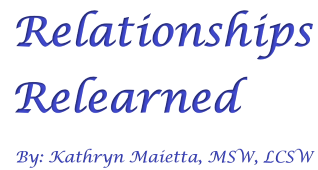
We are all born with “three brains.” Of course this is a figurative concept! No one is born with three brains! The concept of Three Brains is not a scientific representation of brain chemistry or the pathways the brain takes to process information. It is a visual metaphor for conceptualizing three distinct ways our brain responds to stressful events:

• The “human brain” (the largest size of the brain diagram) symbolizes having the capacity for problem solving.
• The “mammal brain” (the medium size brain diagram) symbolizes a focus on the present as opposed to planning for the future.
• The “reptile brain” (the smallest size brain diagram) symbolizes escapism as a coping skill.
Kathryn Maietta, MSW, LCSW designed Three Brains has been designed to demonstrate a visual image of having the power to:
• Process information differently
• Improve how you feel about yourself
• Have healthier relationships with others
Your Human Brain
When you are processing information in your human brain you receive information through a filter of feeling optimistic and productive. You are able to solve complex problems and perform critical thinking. You have goals in life that you feel confident you can accomplish. You have a 401K or other formalized retirement plan. You live life looking forward to the adventure of where life will take you. When you are in your human brain:
• You are flourishing.
• You are strong.
• You control your destiny.
• You are able to solve complex problems.
• You look forward with anticipation to what the future will bring.
• You have intimate, close, caring relationships in which there is love, honesty, commitment and vulnerability.
Your Mammal Brain
When you are processing information “in your mammal brain” you receive information through a filter of resignation and existence, of “going with the flow”. You are able to solve simple problems. You look forward to more immediate events, for example your plans for the upcoming weekend. Your retirement plan is Social Security. Being in your mammal brain is living a philosophy of “it is what it is”. When you are in your mammal brain:
• You are functioning.
• You are in survival mode.
• You feel others are in control of my life (parents, teachers, spouse, boss, the legal system, etc.).
• You “put one foot in front of the other”.
• You may be in a relationship, but it is one of co-existing. Trust, communication and a sense of romance are elusive.
• You live for today without much thought to the future.
Your Reptile Brain
When you are processing information “in your reptile brain” you receive information through a filter of escapism and pessimism. You live our life in passive resistance to the rest of the world. You are not focused on solving problems, but of just “getting by”. Your retirement plan is playing the lottery. Living in your reptile brain includes a complex web of skepticism, despair and insecurity. When you are in your reptile brain:
• You are floundering.
• You react to events around you.
• You feel powerless and hopeless.
• You frequently struggle to maintain a relationship, a job, or stable housing.
• You live life with the philosophy of “one step forward, and two steps back.”
• You use primitive escape coping skills of:
Fight: You don’t “play nicely” with others. You are often irritable and have a hard time maintaining a long term relationship or job.
Flight: You “escape”. You don’t answer the phone and rarely attend family holiday celebrations (isolation). You may drink alcohol to excess, smoke cigarettes and indulge Yourself with comfort foods high in carbs and sugar (chemical escape). You go from one relationship to another, home to home, and job to job (geographic cure). You spend hours listening to music, reading a book, watching movies or playing video games (emotional escape).
Freeze: You do nothing, you don’t make any decisions. You feel like “a deer in headlights”.
Frenzy: You deliberately keep yourself busy so you don’t have time to think. You are the first to volunteer to work overtime. You are a compulsive “neat freak”.
Fawning: You become a “people pleaser”. You find it almost impossible to say no. You ignore your own needs, values and boundaries.
The Circle
The red circle on the diagram to the right is a visual to demonstrate there is a fluid motion between functioning in our human, mammal and reptile brains. Ideally you would like to live in your human brain all the time. However, due to the ongoing barrage of stressful events, being in our human brain all the time is just not possible. Some of the stressful events you have no control over are: a loved one passes away, a cancer diagnosis is received, or a global pandemic strikes. As stressful events occur and unfold you move from our human brain into your mammal or even your reptile brain.

It is also important to remember that you need your psychological “down time”. Being in your mammal or reptile brain on occasion isn’t a problem. What is of concern is when you “spend your life” in the mammal brain or the reptile brain.
Hope is a skill of the human brain. Hope is based on successful problem solving, thriving relationships, goal setting and long range planning. Hope is finding yourself in your reptile brain, and in a fluid movement utilizing skills to move back to your human brain (the circle).
The primary skill for fluidity in moving back to the human brain is recognizing when you have moved into the mammal or reptile brain. You have cues, but do you recognize them?
Examples:
Human Brain:
• Spending regular quality time with family and friends.
• Spending more time having experiences or participating in a hobby rather than watching TV.
• Physically taking care of myself by hydrating, eating well, sleeping comfortably and being active.
Mammal Brain:
• Socialization is limited and with a very small group.
• Expanding my mind is finding a new TV series to watch.
• Meals are eating fast food or processed foods.
Reptile Brain:
• Socialization is avoided.
• Escapism from reality is the focus, be it food, alcohol or Netflix.
• Meals tend to be junk food, sleep is elusive, with little to no planned physical activity.
When we recognize which brain we are in, human, mammal or reptile, we can do something about it.
Resilience
Resilience is the ability to rebound when a stressful event occurs. It is a skill that originates from believing in yourself and is used to:
• Cope with adversity
• Adapt to change
• Accept uncertainly
• Overcome challenges

The diagram to the left demonstrates when a stressful event occurs (a hurricane, loss of a family member or a pandemic) you may move to the mammal brain, “putting one foot in front of the other” until you can utilize positive coping skills to return to the human brain. It is possible during these stressful times to go directly into your reptile brain. The reptile brain provides you with an escape from the stressful event.
If you have ever been in the human brain, no matter the adversity, you will be able to return. If you have lived most of your life in your mammal brain, and you find yourself in the reptile brain, you can learn coping skills to move back to the mammal brain and even to the human brain.
Suggested Coping Skills:
1. Get active, take a walk, do something physical.
2. Spend time with positive family and friends.
3. Have a new experience.
4. Turn off the TV, computer, phone.
5. Develop goals (a “bucket list”).
6. Pay it forward, do something nice for someone else.
7. Practice good sleep hygiene (dark, cool, quiet bedroom).
8. Eat healthier.
9. Drink water.
10. Find, work toward, maintain hope.
For more information, read my article 30 Ways to Boost Resilience.
Which Brain are you in?
The theory of the Three Brains focuses on three different types of coping skills to process information and problem solve:
• Critical thinking coping skills: taking action and looking forward with optimism (the human brain)
• Problem-solving coping skills: observing what is with a focus on today (the mammal brain)
• Escapism coping skills: reacting to stress by trying to escape, with minimal concern for the future (the reptile brain)
Example:
Terry works 12 hours shifts as an ICU nurse at the local hospital. It is a job requiring Terry to balance paying attention to detail with patients, demonstrating compassion with family members, and interacting with peers in a professional manner. During work Terry is processing information in a human brain.
The 45 minute drive home is one of “autopilot”. Terry takes the same route home, carefully observing the rules of the road. It is all so routine that Terry couldn’t even recall pushing the garage door clicker to open or close the garage door. It is about getting home. Now. This is processing information in a mammal brain.
Once at home, Terry turns on the TV and while watching a recorded rerun of the People’s Court, Terry eats half a pint of Haagen-Dazs ice cream. This is an example of being in a reptile brain.
As Terry is finishing the half pint of ice cream, there is a realization that eating ice cream isn’t a very healthy meal. Terry then goes out to the kitchen, starts drinking a glass of water and prepares a healthy meal. Terry recognized the reptile brain behavior (eating ice cream for supper) and makes the conscious decision to move back to the human brain (Terry drinks water and eats a well-balanced meal).
Sometimes it is not easy to be in your human brain. It is easier to open the container of ice cream than it is to make a well-balanced meal! It isn’t “bad” to sometimes be in your reptile brain when you just need to “shut down and regroup”. The idea is to be in your human brain as much as possible by:
• Self-awareness (recognizing when we are in our reptile brain) and
• Coping skills (using your skills to return to the human brain).
Which brain are you in?
AI has not been used to create any content for or my website, articles, blogs or books. All material is original unless otherwise noted.
All photos and graphics within my website and blogs were taken or created by David Harrington or Kathryn Maietta.
Published: 9/20
Revised: 6/24
My Most Recent Blog Posts
- Strengthening & Enforcing Boundaries: Your How to Guide October 7, 2025
- Red Flags: An Excerpt From My Relationships Relearned Book September 23, 2025
- Real Information, Disinformation, Misinformation and Malinformation September 9, 2025
- How is Your Self-Esteem and Confidence? August 26, 2025
- Finding Levi, the 1st Story in The Charlotte Novella Series August 21, 2025
- Loss Aversion – Do You Focus More on Losses Than Wins? August 12, 2025
- Five Important Coping Skills for a Restful Sleep July 29, 2025
- Why Are Setting Goals Powerful? July 15, 2025
- Aggression – The 10 Types From My Anger Management Book July 1, 2025
- Affects of “The Shoulds,” “FOND,” and “Productivity Anxiety June 17, 2025






